|
⇐ Previous Article — Table of Contents — Next Article ⇒
New Energy Times home page
2. Cold Fusion is Neither
By Steven B. Krivit
On March 23, 1989, the world witnessed a science discovery that ignited what may very well be the greatest science controversy of the last 100 years.
It began publicly when electrochemists Martin Fleischmann and Stanley Pons, at the University of Utah, announced to the world that they had discovered what became popularly known as "cold fusion."
Since then, an eclectic group of researchers has been following the pair's footsteps in a two-fold struggle: one, to understand the phenomenon; and two, to convince the rest of the world that "cold fusion" is real.
The researchers have claimed that "cold fusion" is the same underlying process as the well-known and accepted thermonuclear phenomenon that appears to occur on the sun, in the stars, and in million-degree experimental test chambers around the world. However, the "cold fusion" researchers have claimed that they can make fusion much more easily and less expensively than the thermonuclear fusion researchers can.
When Fleischmann and Pons first made their discovery, they did not even speculate that their results were caused by the other well-known nuclear process, fission. Their results looked nothing like fission; they were missing key characteristics of fission reactions, and they were not using materials required to create fission reactions.
Fusion was Fleischmann and Pons' best guess because they, as well as most other scientists at that time, were not aware of a third nuclear possibility: weak-interaction processes. Even people who knew about weak interactions had no idea that weak interactions could, in fact, be very energetic, enough to explain the nuclear-scale heat that Fleischmann and Pons observed.
Many "cold fusion" researchers believed that, if deuterium was present in the experiment as an input and helium was present as an output, then by some miracle, nuclear fusion was occurring, even if the idea of room-temperature "cold fusion" contradicted 70 years of experimental and theoretical groundwork. It was as simple as 2+2=4. That is, two deuterons make one helium-4.
Through the 1990s, researchers discussed the "cold fusion" idea in papers and conference presentations, primarily as an hypothesis. Beginning around 2000, however, the character of the discussion shifted. Some LENR researchers began discussing this idea as a fact, not an hypothesis.
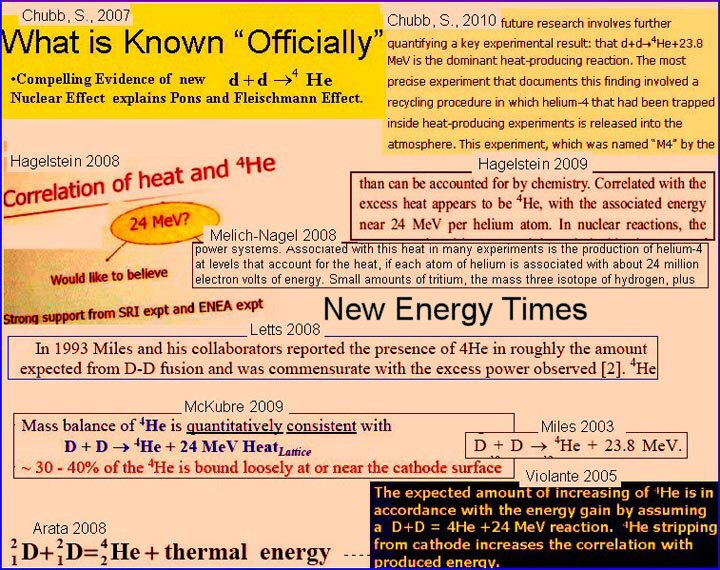
But that little step in the middle where cold nuclear fusion supposedly took place between the two deuterons has always been a problem – a problem that is at the root of some of the most bitter and contentious science debates in the last 100 years.
The logical shift of the D+D "cold fusion" hypothesis to an official fact, however, didn't take place because the researchers made new discoveries. Instead, to get to their new official position, the "cold fusion" researchers invented theories that relied on new physics, invented new untested concepts of metallurgy, were very selective about the data they chose to consider and report as accurate, and, in rare but significant cases, made unscientific changes to data.
Eventually, in 2006, Lewis Larsen and Allan Widom helped the world to see how "cold fusion" could be explained much better by, primarily, weak-interaction processes. Like most new ideas, theirs did not take quickly. In fact, it drew bitter opposition and hostility from researchers who had fixed their minds on "cold fusion."
With hindsight, observers can see that LENR does not look at all like fusion. Only one kind of fusion is and always has been scientifically confirmed: thermonuclear fusion.
When deuterium-deuterium thermonuclear fusion occurs, three sets of reaction products come out.
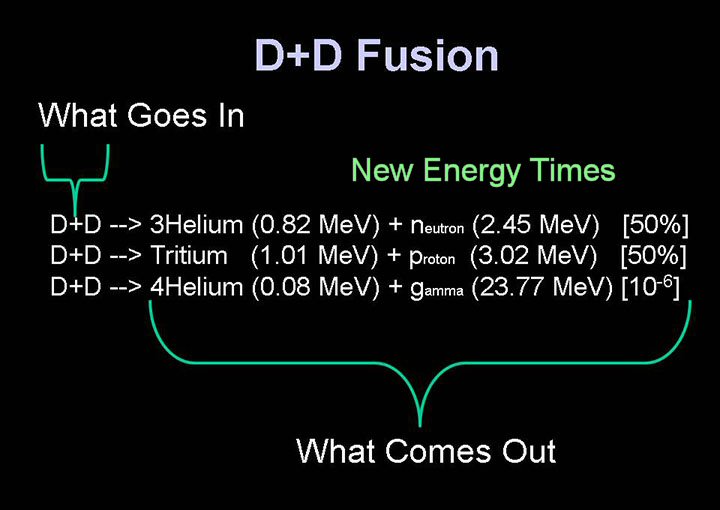
In the first set, or branch, a helium-3 atom and a neutron are produced. This reaction pair makes up about 50 percent of the total reaction products from a given set of fusion reactions. The second set produces a tritium atom and a proton. As with the first branch, these products also make up about 50 percent of the total reaction products. The third branch produces a helium-4 atom along with a gamma ray, but this branch occurs very rarely, about one time in a million.
These relationships are specific and constant. In fusion, all three branches occur, and they all occur with the known probabilities (~50%, ~50% and 10-6), and each branch always has its specific pair of reaction products.
Within each branch, the physics is even more specific. Each product emits precisely known kinetic energy. The entire set of data is very specific and is confirmed by both theory and experiment.
Even "cold fusion" researchers acknowledge that "cold fusion" does not look like fusion as we now know it. Within the field however, there is little argument that LENR produces, among other products, helium-4 and nuclear-scale energy, in the form of heat.
But many LENR researchers took these two phenomena, disregarded all the other LENR phenomena, and asserted for many years that helium-4 and heat are the only products or only main products of LENR. Their hypothetical adaptation of fusion to "cold fusion" looks like this:
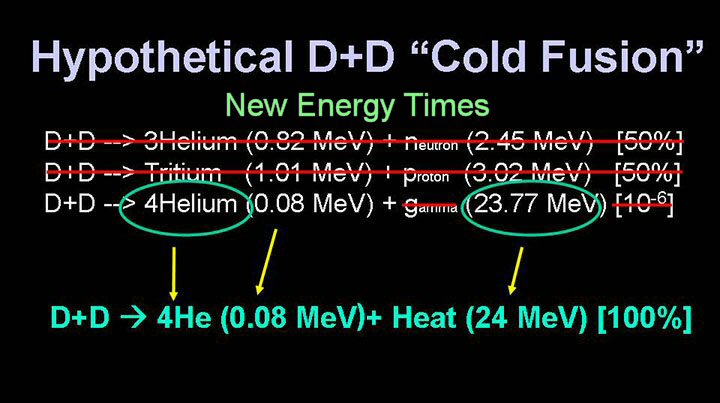
Michael McKubre and Vittorio Violante are two of the leading proponents of the "cold fusion" hypothesis. Two months ago, New Energy Times published an investigation about the pair's "cold fusion" claims.
The "cold fusion" hypothesis may be on its way to obsolescence, however, because McKubre and Violante, for the first time in perhaps a decade, omitted any reference to this hypothesis as part of their presentations at the March 2010 American Chemical Society national meeting.
The "cold fusion" hypothesis developed from several fundamental assumptions; here are three of the most significant ones.
|
Assumption #1: Helium-4 as the Sole Product
Early in "cold fusion" history, researchers were not seeing and they are still not seeing amounts of helium-3, neutrons, tritium or protons large enough to explain the excess heat. These were the expected products from deuterium-deuterium nuclear fusion. Eventually they recognized helium-4 as the dominant gaseous product of LENR. Because many "cold fusion" researchers were looking at "cold fusion" through the lens of fusion and because they didn't see the expected nuclear fusion products, they assumed that there were no other nuclear products such as isotopic shifts or elemental transmutations.
Assumption #2: 24 MeV Heat per Atom of Helium-4 as the Total Energy
Attached to the first assumption of helium-4 is the "cold fusion" researchers' assumption that they should expect about 24 MeV heat per atom of helium-4 as the total energy of the system, because 24 MeV is the mass difference between a pair of deuterons and a helium-4 atom.
Assumption #3: Helium-4 Is Born With an Energy of 20.2 KeV or Less
For Assumption #2 to be valid, the helium-4 atom must be emitted with no more than 20.2 KeV. Otherwise, the math doesn't balance, and "cold fusion" won't look even remotely like the third branch of fusion.
|
However, these assumptions have fundamental problems:
Problem #1: LENR Products Are Inconsistent With the Hypothesis of D+D "Cold Fusion"
For the "cold fusion" hypothesis to be valid, the researchers had to ignore a multitude of other nuclear products and phenomena that had been reported throughout the 21 years of LENR research. Most researchers in Russia, Italy, France, India and Japan maintained a broader perspective and paid more attention to these other phenomena than did their counterparts in the U.S. The slide below depicts some of the other products and effects of LENR, which are inconsistent with the hypothesis of D+D "cold fusion."
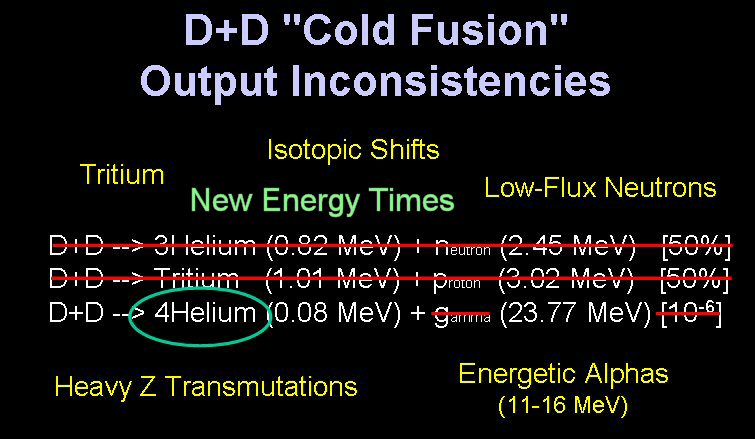
Problem #2: LENR, in General, Doesn't Produce 24 MeV
On March 21, 2010, Peter Hagelstein made the following statement at the American Chemical Society press conference on "cold fusion" about the alleged 24 MeV in LENR experiments:
The evidence in support of helium associated with energy production in the Fleischmann-Pons experiment — that helium-4 is seen in association with excess power — comes from a number of experiments — more than 10 experiments where people have seen that kind of thing — and there's two measurements where the correlation shows a Q-value or an energy per helium-4 of about 24 MeV.
At the 14th International Conference on Condensed Matter Nuclear Science in Washington, D.C., in August 2008, Hagelstein said that he would like to believe in the 24 MeV hypothesis. He specifically mentioned that the SRI International experiment, led by Michael McKubre, and the ENEA-Frascati experiment, led by Vittorio Violante, provided "strong support" for this belief. Thus, we know the two best experiments on which Hagelstein bases his belief in the 24 MeV hypothesis.
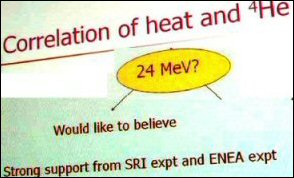
Hagelstein's slide from 14th International Conference on Condensed Matter Nuclear Science
in Washington, D.C.
One problem is that, to get the value of 24 MeV that SRI International reported, McKubre made 12 unscientific changes and representations between 2000 and 2009 to data from an experiment that was performed in 1994. See "When Nuclear Is Not Enough: A Tangled Tale of Two Experiments" for full details.
A second problem is that Violante said that he had obtained a 24 MeV value, yet when New Energy Times scrutinized his representation of "24 MeV," Violante clearly had not obtained such a value, and he admitted as much after responding to questions from New Energy Times.
What does a broader search for "24 MeV" turn up? The following slide lists the most well-known experimental studies:
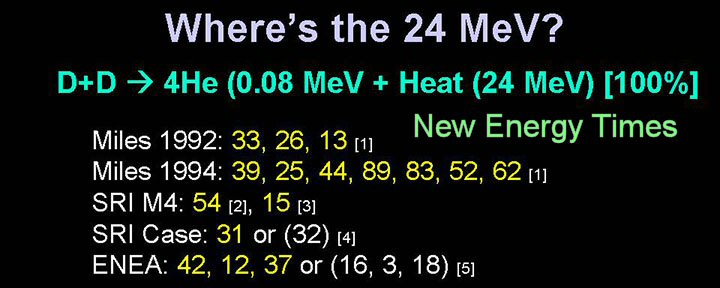
The values from these five sets of experiments run a wide spectrum, ranging from 12 to 89 MeV.
In contrast with the "cold fusion" claims made by McKubre and Hagelstein in their publications for SRI experiment M4[4,6], the scientific documentation[2,3] does not show a value of 24 MeV but rather values for 54 MeV in one run and 15 MeV in the other.
Similarly, Violante's experiments do not show a value of 24 MeV but values of 42, 12, and 37 MeV, or 16, 3, and 18 MeV, depending on how you read the helium-4 background value.
The closest single experimental run to 24 MeV was that of Melvin Miles in 1994, when he worked at the Navy's China Lake laboratory. The average of all those runs gives 56 MeV. However, the average of his 1992 runs gives 24 MeV. As explained in "Bockris' and Miles' Historic Confirmations of LENR-Produced Helium" in this issue of New Energy Times, Miles, however, has never reported this value in a paper or presentation.
Problem #3: Energy Balance Inconsistencies
Even if LENR experiments did produce a total of 24 MeV per helium-4 atom, those two phenomena, heat and helium-4, are meaningless. Meaningless? After all this drama and debate about the proximity or not of LENR experiments to 24 MeV?
They are meaningless because there are other nuclear reaction products (and possible inputs) in LENR experiments, with both heavy and light hydrogen, that release nuclear energy.
Instead of the simplistic D+D –> 4He + Heat (24 Mev), what is really happening is more like D+D + a + b + c –> 4He + x + y + z, where a, b and c are other inputs and x, y and z are the other products. Unless researchers know precisely what energy is associated with all nuclear products in the system, attributing a specific amount of energy to any one of the nuclear products, for example, 4He, in the system is impossible.
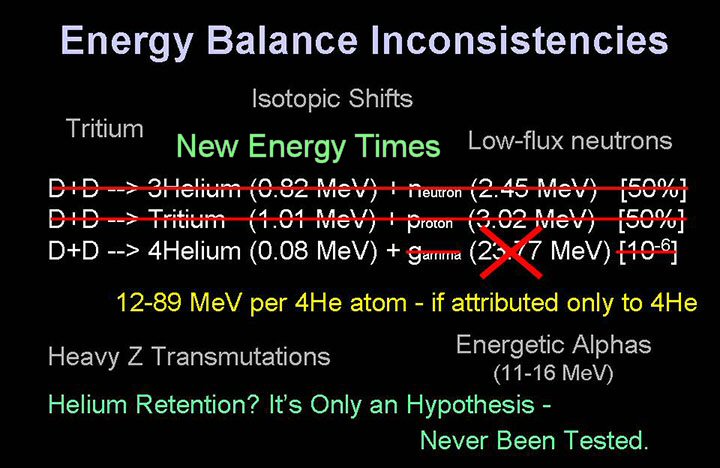
Many "cold fusion" proponents have suggested that there are no other energetic nuclear products in these systems. They have also suggested that the other nuclear products occur only in light hydrogen systems, not the deuterium/palladium systems. These are both myths. See "Isotopic Anomalies Reveal LENR Insights" and "Who's Afraid of LENR Transmutations?" in this report.
There are also gross inconsistencies with the products of fusion compared with LENR, as the product ratios in this image show:
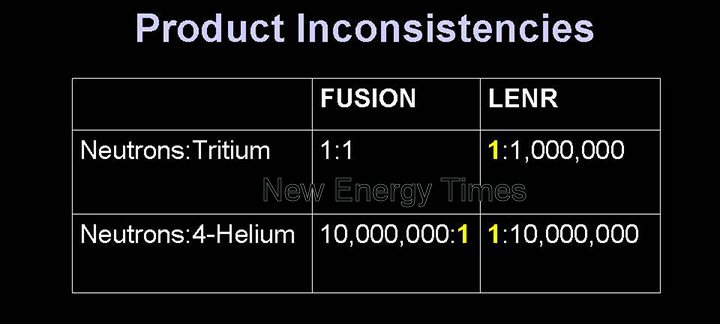
The ratio of neutrons to tritium in fusion versus LENR is directly opposite, as is the ratio of neutrons to helium-4.
And then there are the inconsistencies of the input materials that are used in fusion compared with LENR.
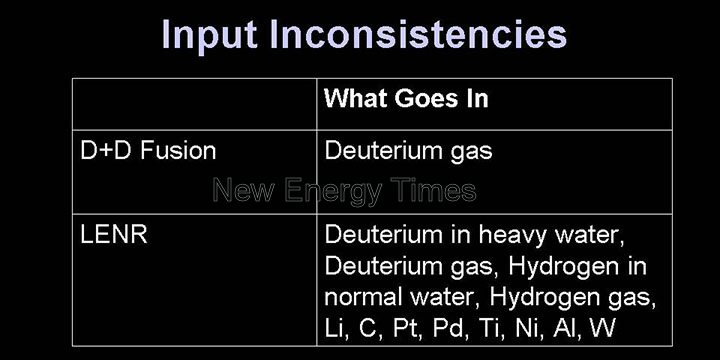
The input materials to D+D fusion are very simple: deuterium gas. The inputs in LENR systems are a complex and highly variable mixture of materials.
One of the few people who took a more holistic view of LENR was George Miley, a professor at the University of Illinois. Miley's background is in nuclear research, and he earned his Ph.D. in chemical and nuclear engineering.
In 2003, he presented his picture of LENR phenomena, compared with thermonuclear fusion.[7] Miley saw that LENR transmutations and "cold fusion" were part of the same larger picture. Of course, he, like many other researchers, understood that the LENR transmutations could not be explained by "cold fusion."

Miley's 2003 general comparison of thermonuclear reaction products (first three rows)
to LENR reaction products (fourth row).
For many years, the loudest proponents of "cold fusion" have repeated Nobel Laureate Julian Schwinger's mantra in explaining why "cold fusion" doesn't look like fusion.

With the benefit of hindsight and 21 years of scientific research to draw on, it is clear that the circumstances, inputs and products of LENR are not those of fusion: hot, cold or otherwise.
References
1. Miles, M., "Correlation of Excess Enthalpy and Helium-4 Production: A Review," Proceedings of the Tenth International Conference on Cold Fusion, Cambridge, Mass. (2003), pg. 6 "theoretical rate of 2.6x1011 4He s-1W-1" Sample math calculation: 2.6 (x10^11) / 1.4 (x10^11) * 23.85 = 44 MeV/4He, Corrections via May 21, 2010 e-mail.
2. EPRI TR-107843-V1, pg 3-223, pdf pg 351; Math: 22.4/41=0.54.
3. EPRI TR-107843-V1 pg 3-223, pdf pg 351; Math: 1.66/1.13 = 147%; 22.4/147=0.15.
4. McKubre, M., Tanzella, F., Tripodi, P., and Hagelstein, P., "The Emergence of a Coherent Explanation for Anomalies Observed in D/Pd and H/Pd System: Evidence for 4He and 3He Production," Proceedings of the Eighth International Conference on Cold Fusion, Lerici, Italy (2000).
5. Apicella, M., Castagna, E., Capobianco, L., D'Aulerio, L., Mazzitelli, G., Sarto, F., Rosada, A., Santoro, E., Violante, V., McKubre, M.C.H., Tanzella, F., Sibilia, C., "Some Recent Results at ENEA," Proceedings of the Twelfth International Conference on Cold Fusion, Yokohama, Japan (2005).
6. Hagelstein, P., McKubre, M., Nagel, D., Chubb, T., and Hekman, R., "New Physical Effects In Metal Deuterides," submitted to the 2004 U.S. Department of Energy LENR Review.
7. Miley, G.H. and Shrestha, P., "Review of Transmutation Reactions in Solids," Proceedings of the Tenth International Conference on Cold Fusion , Cambridge, Mass., (2003).
⇐ Previous Article — Table of Contents — Next Article ⇒ |

